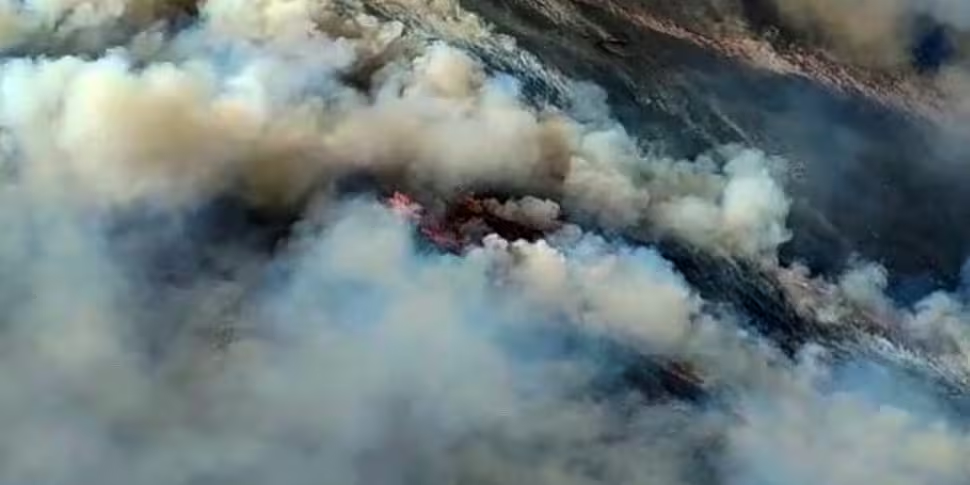Wildlife campaigners have warned that the supposed system of controlled farmland burning in Ireland is more like a “tradition of throwing a match into the heather and walking away.”
It comes after up to half the lands in Killarney National Park were damaged in a major blaze over the weekend.
The cause of the fire has not been established; however, the Irish Wildlife Trust (IWT) has called for a “cultural shift” to bring an end to the burning of land for agricultural purposes.
On Newstalk Breakfast this morning, IWT spokesman Pádraic Fogarty refused to speculate on the cause of the Killarney fire but warned that, “in the broader picture we absolutely know that farming practices play a role in this.”
“We have to remember that the tradition of burning land goes back a very long way,” he said.
“We have been dealing with fires like this in the Irish Wildlife Trust for at least a decade; we know that the Killarney National Park is burned down practically annually and they happen all over the place.
“Even last weekend, they happened all over the place. Definitely agriculture has a role in this.”
Firefighting operations ongoing in #KillarneyNationalPark today, please exercise caution if in the area pic.twitter.com/wioFPXAJmq
— Irish Air Corps (@IrishAirCorps) April 24, 2021
While it is illegal for farmers to burn any growing vegetation between March and August each year, many fires are annually reported out of season.
Meanwhile environmentalists have pointed out that national fire warnings – encouraging people not to light barbeques or smoke cigarettes in the countryside can take the focus off the main causes of wildfires in Ireland.
“We know that the system is set up to promote burning of land, clearing of land and destruction of habitats,” said Mr Fogarty.
“Most farmers who receive the Single Farm Payment – that is the subsidy system they get – have to have their land in what is called grazable condition.
“There are a whole series of rules to make sure that you don’t have bushes, you don’t have scrub, or you don’t have a bit of vegetation above your knee in order to get this payment and of course that is a principal driver for the loss of habitat including burning land like this.”
Today is #EarthDay2021. Fire can be extremely damaging to the environment, not only to air quality but also to natural habitats.
🙌🏼Do your bit to prevent wildfires this year.
🚬Dispose of cigarettes responsibly.
🍗Do not use BBQ’s outside designated areas.
🦶🏼Leave no trace pic.twitter.com/bCJoG5iB5x
— Dublin Fire Brigade #StayHomeSaveLives (@DubFireBrigade) April 22, 2021
Also on the show, the Irish Farmers Association (IFA) President Tim Cullinan said farmers and farm animals have coexisted with ecosystems in mountainous areas for many, many years.
“There is a system of managing the areas within a period of the year which is a closed period and that is what farmers have been doing for years,” he said.
He said there are no better people than farmers to understand and manage tough mountain terrains.
“I can’t accept that farmers are responsible for all of this,” he said. “There is a system for controlled burning on hills and farmers have been doing that for years.
“The other thing to remember is farmers do get an EU payment but the land has to be in good condition so the last thing farmers want is for the land to be burnt as well – because that will impact on them when they can’t claim their payment.”
#heartbreaking a Sika Hind Deer with her family, against the burnt hillside between Glaisín na Marbh & Eagles Nest #KillarneyNationalPark following the devastating #fire @DeptHousingIRL @Irishwildlife @MountainIrl @DarraghOBrienTD @countykerry @BioDataCentre pic.twitter.com/v2YY5aH1s2
— Valerie O'Sullivan (@valphoto) April 27, 2021
Mr Fogarty said The National Parks and Wildlife Service has already warned that all of Ireland’s upland habitats are in bad condition, while Birdwatch Ireland has warned two-thirds of our bird species are being driven to extinction.
“We are very, very far from a harmonious system,” he said. “Even what Tim was saying about a tradition of controlled burning outside the season, I am afraid that doesn’t exist.
“We have been doing the research on this and we know that the number of so-called controlled burns is less than ten out of the hundreds of fires we see every year.
“So, there is no tradition of controlled burning. There is a tradition of throwing a match into the heather and walking away.”
You can listen back here:









